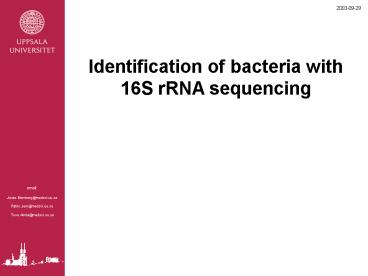Identification of bacteria with - PowerPoint PPT Presentation
1 / 18
Title:
Identification of bacteria with
Description:
The degree of sequence similarity reflects phylogenetic distance, i.e. the more ... 16S = the sedimentation coefficient in ultra centrifugation, measured in Svedberg ... – PowerPoint PPT presentation
Number of Views:1739
Avg rating:3.0/5.0
Title: Identification of bacteria with
1
2003-09-29
Identification of bacteria with 16S rRNA
sequencing
2
2003-09-29
Identification of bacteria
Patient sample (blood, urin, faeces)
Primary culture
- Selective growth media - Antibiotics
Secondary culture
Identification?
Biochemical typing
API strip
Identification
3
2003-09-29
Why sequencing?
Cultivation of bacteria fails - cultivation
methods are lacking - the bacteria are to few
to be cultivated - the bacteria are
inactive Biochemical identification fails -
methods are missing - the bacteria do not
perform biochemically correct
4
2003-09-29
Identification Flowchart
Patient sample (blood, urin, faeces)
Primary culture fails
Sequencing
Secondary culture
Identification?
Biochemical typing
Identification fails
Sequencing
5
2003-09-29
The Molecular Clock
Criteria -Randomly occuring mutations at
neutral sites -Constant mutation rate The
degree of sequence similarity reflects
phylogenetic distance, i.e. the more similar the
sequences- the more closely related the
species Ribosomal genes - contain regions
that are conserved among all self replicating
organisms, together with highly variable
regions -Are large enough to contain
adequate amount of information
6
2003-09-29
Evolutionary tree of the domain Bacteria
7
2003-09-29
The bacterial 16S rRNA molecule
Part of the ribosomal small subunit together with
a set of ribosomal proteins 16S the
sedimentation coefficient in ultra
centrifugation, measured in Svedberg rRNA
ribosomal RNA 1500 bases long RNA molecule
Conserved regions primer design Variable
regions identification
8
2003-09-29
Historical highlights of the bacterial 16S rRNA
molecule
- Woese Fox 1977 Archaea, Bacteria and
Eucaryotes could be classified acording to their
phylogeny - Classification of bacteria with phylogenetic
trees - Detection of non-cultivatible bacteria. 99 can
not be cultivated! - Wilson et al. 1991 Identification of the
etiologic agent of Whipples disease
9
2003-09-29
Sequencing of the 16S rRNA gene
- DNA extraction 1 h (more for gram positives)
- PCR 2,5 h
- Cycle sequencing 3 h
- Sequence analysis 1,5 h
- Editing of raw data 20 min
- Search in database 10 min lt 9 h
10
2003-09-29
Conclusions
11
2003-09-29
Lab. Groups
12
2003-09-29
Wet-Lab content
- DNA preparation
- PCR with primers directed against 16S rDNA
- Analysis of PCR product on agarose gel
- Purification of PCR product
- Cyclic Sequencing reaction (PCR)
- Automated sequencing
- Identification of organism by database searches
13
2003-09-29
PCR with primers directed against 16S rDNA
- Each PCR reaction containing
- Master Mix (dNTP, MgCl buffer)
- TaqDNApolymerase
- Forward Reverse Primers
- DNA Template
- Water to adjust the reaction volume
The samples are put in a Thermocycler 95C,
5min. Initial denaturation 95C,
45s. Denaturation of DNA 50C, 45s. Annealing of
Primers 72C, 1min. Elongation of new DNA 72C,
10min. Final elongation
X 35
14
2003-09-29
Purification of PCR product
- Commercial kits (e.i QIAqiuck Spin) are used to
remove the excess of primers and nucleotides from
the PCR reaction - The principle
- Binding of DNA to a silica filter at a suitable
pH, adjusted with a buffer solution - Washing the DNA with a wash buffer
- Elute the DNA by changing the pH with another
buffer solution
15
2003-09-29
Cyclic Sequencing reaction (PCR)
16
2003-09-29
Identification of organism by database searches
BLAST www.ncbi.nlm.nih.gov
BLAST- search at the National Center for
Biotechnology Information (NCBI) site by using
the retrieved nucleotide sequence (or translated
amino acid sequence) in FASTA- format gtSeqname
Nucleotide sequence........
17
2003-09-29
Computer sessions
http//www.kvir.uu.se/molbiokurs/molbiokurs_uu.htm
l
18
2003-09-29
Demonstration of some useful techniques in
molecular biology
- Real- time PCR
- Automated Capillary Sequenator
- Amersham Pharmacia Biotech
- Gyros

